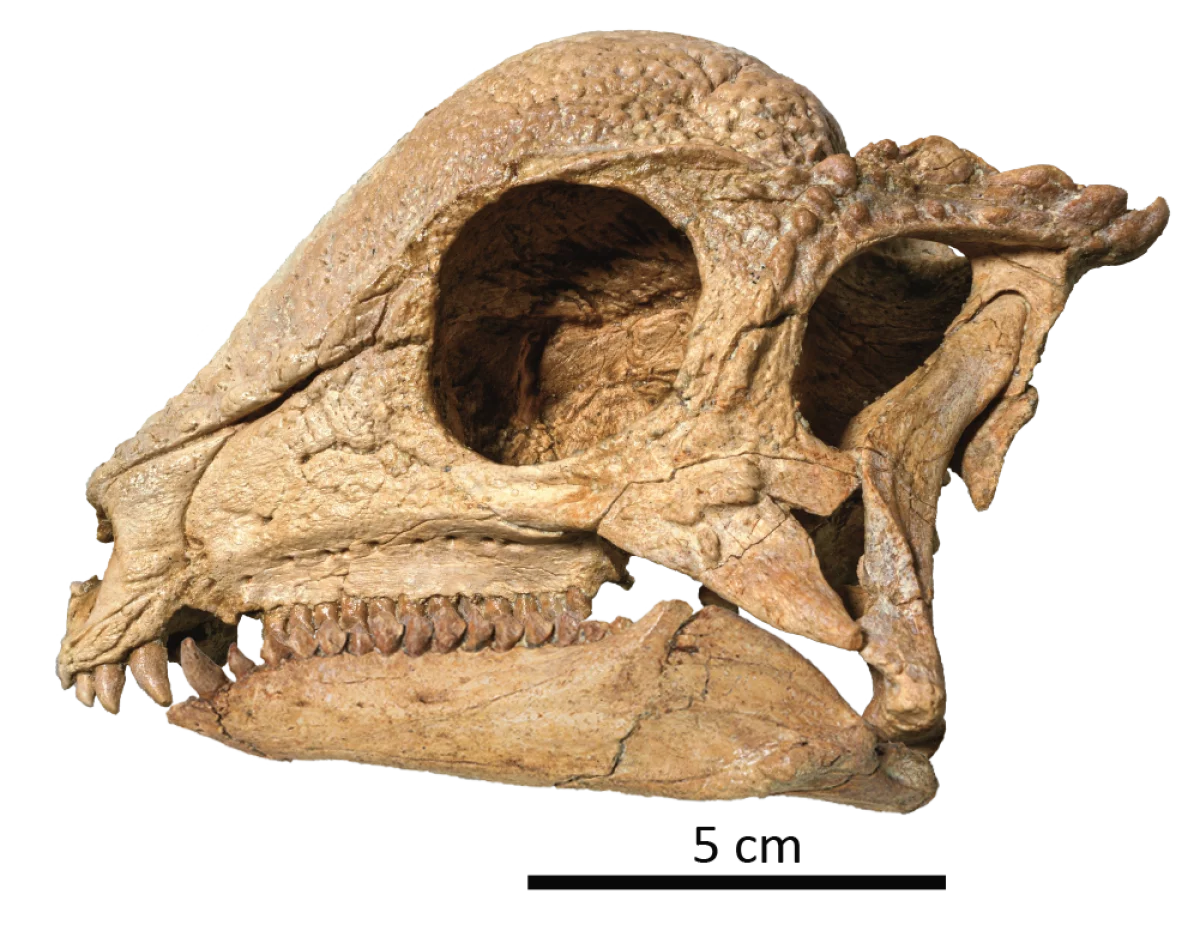On a cloudy morning in southeastern Mongolia, paleontologist Chinzorig Tsogtbaatar and his team embarked on a routine walk from their campsite to a rocky outcrop dating back roughly 110 million years to the Early Cretaceous. But within minutes, Tsogtbaatar noticed something unusual glinting on the hillside. “It didn’t look like a rock,” he recalls. “It was very unusual.”
As he drew closer, the object revealed itself: a dome-shaped skull. Tsogtbaatar instantly realized he had stumbled upon something remarkable — the fossil of a previously unknown species of dinosaur. The team would later name it Zavacephale rinpoche, a nod to the Tibetan word rinpoche, meaning “precious one,” inspired by the skull’s jewel-like appearance in the sun.
Why This Discovery Matters
Zavacephale rinpoche is significant for several reasons:
- Oldest Known Pachycephalosaur – At around 110 million years old, this fossil predates previously known dome-headed dinosaurs by 15 million years, pushing back the timeline for this group.
- Most Complete Skeleton Found – While pachycephalosaurs are typically known from partial skulls, this specimen includes many additional bones, making it the most complete skeleton ever unearthed for the group.
- Juvenile With Fully Developed Dome – Remarkably, the fossil belonged to a juvenile, yet the dome was already fully formed, indicating that these features developed early in life.
- New Anatomical Insights – For the first time, researchers recovered hand bones and other skeletal elements, plus gastroliths (stomach stones), shedding light on diet, locomotion, and growth.
This discovery does more than just add a new name to the dinosaur family tree — it fundamentally changes how paleontologists understand pachycephalosaur evolution.
Anatomy and Lifestyle
Zavacephale rinpoche was relatively small, roughly the size of a large German shepherd, weighing around 5–12 pounds as a juvenile. Its most striking feature, the dome-shaped skull, was made of solid bone and decorated with spikes along the edges. Researchers believe these domes were likely used for social displays or competition, not for predator defense.
Tail and Limbs:
The tail was reinforced with bony tendons, making it rigid and potentially useful for stability or display.
Tiny hand bones suggest limited manual ability, meaning the dinosaur relied on other adaptations rather than its arms for interaction or survival.
Behavioral Insights:
Juvenile dinosaurs like Zavacephale were already practicing dome-related behaviors, hinting at early social interaction or competition for mates and territory.
Evolutionary Implications
Before this find, most pachycephalosaurs were known from the Late Cretaceous of North America, approximately 80–66 million years ago. Zavacephale shifts the group’s origin back by 15 million years and firmly places it in Asia.
This has several implications:
Dome structures formed earlier than previously thought, suggesting complex social behavior emerged in juveniles.
Pachycephalosaurs may have originated in Asia before spreading to other regions.
Juvenile specimens can reveal unexpected aspects of anatomy and behavior, challenging long-standing assumptions.
Dr. David Evans, a dinosaur paleontologist not involved in the study, notes, “This fossil fills a critical gap in understanding the early evolution of dome-headed dinosaurs. Its completeness is truly extraordinary.”
The Story Behind the Fossil
The fossil was discovered in the Khuren Dukh Formation, Eastern Gobi Basin, a remote region known for yielding rare Cretaceous fossils. Tsogtbaatar recalls seeing the dome protruding from the rock like a “perfectly polished jewel.”
Excavation took place in 2019, and the fossil remained in Mongolia through the COVID-19 pandemic. In 2022, it was transported to North Carolina State University for further study. Dr. Lindsay Zanno, co-author of the study, described her first encounter with the skull: “It was enchanting. The most beautiful specimen I’ve ever seen. It’s magical.”
The genus name, Zavacephale, combines a word meaning “root” or “origin” with kephale, Greek for “head,” acknowledging both its ancient position in the pachycephalosaur lineage and its iconic dome.
What We’ve Learned
Zavacephale rinpoche provides insights that were previously impossible to confirm:
Juveniles developed domes early, suggesting that head-butting or display behaviors started young.
Gastroliths indicate a diet that required stones to aid digestion.
The reinforced tail implies structural support, possibly for balance or signaling.
Hand anatomy reveals that these dinosaurs were lightweight and lightly built, with specialized limbs.
Dr. Cary Woodruff, a curator of vertebrate paleontology, highlighted its uniqueness: “Usually, paleontologists work with fragments and imagine the rest. Here, it was all there — teeth, skull, tail, and limbs. This is the specimen that answers questions we’ve had for decades.”
Why U.S. Audiences Should Care
For American readers familiar with Late Cretaceous dome-headed dinosaurs from places like Montana or the Dakotas, Zavacephale rinpoche is a reminder that the story of these dinosaurs is global. It shows:
Dome-headed dinosaurs were evolving millions of years earlier than their North American counterparts.
Asia played a pivotal role in the early evolution of this group.
Even juvenile fossils can overturn assumptions about growth, behavior, and anatomy.
This discovery reinforces the idea that the fossil record is far from complete, and that each new find has the potential to rewrite scientific history.
Conclusion
Zavacephale rinpoche, a small dome-headed dinosaur from Mongolia, is a game-changer. As the oldest and most complete pachycephalosaur, it challenges previous notions about dome development, juvenile behavior, and the group’s geographic origins. From gastroliths in its stomach to tiny hands and a fully formed dome, this fossil provides a window into the life of a dinosaur that roamed Asia 110 million years ago.
For paleontologists and dinosaur enthusiasts alike, Zavacephale rinpoche is more than a fossil — it’s a story of discovery, evolution, and the continuing surprises of our planet’s deep past.

